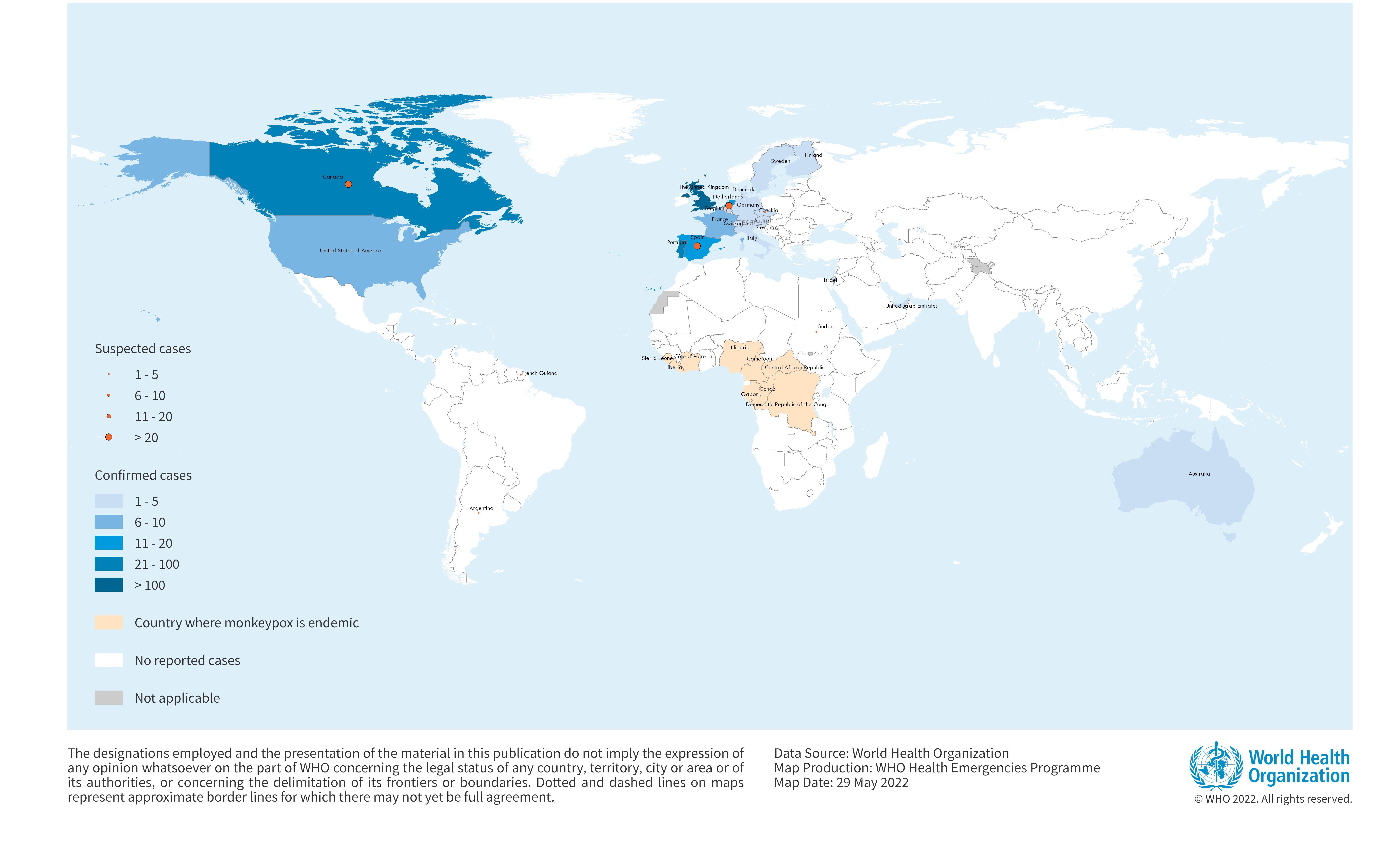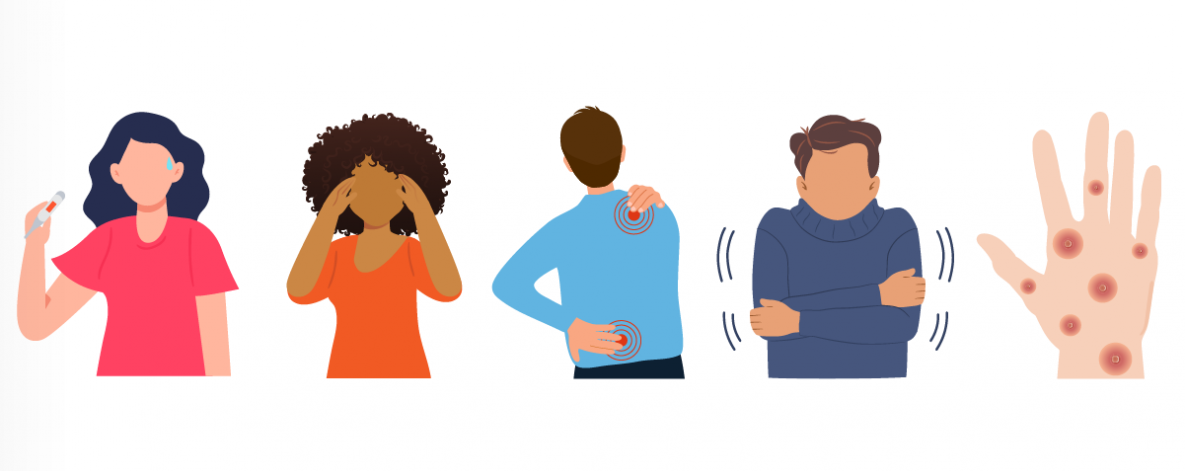
By: Keith Schneringer | July 13, 2022
In this three part blog series, we will be discussing what we know so far about the hMPXV virus (aka "monkeypox"). The hMPXV virus has emerged in headlines on a global scale and it is important to understand the facts in order to prevent the spread of this virus. The main purpose of this blog is to provide useful information about the virus such as its history, symptoms, transmission, prevention, and effective infection control strategies.
Overview
According to the Centers for Disease Control and Prevention (CDC), hMPXV is a rare disease that is caused by infection with the hMPXV virus. In May 2022, the World Health Organization (WHO) reported that multiple cases of hMPXV were identified in areas around the world which do not typically experience cases (including the United States), and studies are currently underway to further understand the epidemiology, sources of infection, and transmission patterns of this virus.
What is known is the hMPXV virus is nothing new, and the virus is already endemic in several countries in Africa. When cases started appearing beyond the expected places – and among people who didn’t travel to those endemic regions – researchers began to pay more attention, as described by Johns Hopkins Blomberg School of Public Health.
The hMPXV virus is a viral zoonosis (in other words, a virus which has been transmitted to humans from animals) with symptoms very similar to those seen in the past in smallpox patients. However, hMPXV is clinically less severe than smallpox, according to the World Health Organization (WHO) The clinical presentation of hMPXV resembles that of smallpox, a related Orthopoxvirus infection which was declared eradicated worldwide in 1980. hMPXV virus is an enveloped virus which belongs to the Orhopoxvirus genus in the family Poxviridae. The Orthopoxvirus genus also includes the variola virus (which causes smallpox), the vaccinia virus (which is used in the smallpox vaccine), and the cowpox virus.
HMPXV was first discovered in 1958 when two outbreaks of pox-like disease occurred in colonies of monkeys kept for research, hence the name “monkeypox.” The first human case of hMPXV was recorded in 1970 in the Democratic Republic of the Congo (DRC) during a period of intensified global effort to eliminate smallpox.
 Image provided by: World Health Organization
Image provided by: World Health Organization
Since 1970, hMPXV has been reported in people in several other central and western African countries such as Cameroon, Central African Republic, Cote d’Ivoire, Democratic Republic of the Congo, Gabon, Liberia, Nigeria, Republic of Congo, and Sierra Leone. At this time, and historically, the overwhelming majority of global infections occur in the Democratic Republic of the Congo.
HMPXV cases in people which have occurred outside Africa may also be linked to international travel or imported animals, and throughout May 2022 there have been several cases reported in the United States, Canada, Portugal, Spain, and the United Kingdom, among other countries.
The natural reservoir of hMPXV remains unknown. However, it is suspected that African rodents and non-human primates (like monkeys) may harbor the virus and infect people. Uncertainty remains on the natural history of hMPXV virus, and further studies are needed to identify the exact reservoir(s) and how virus circulation is maintained in nature.
It is important to note that hMPXV cases in the United States are still extremely rare, according to the CDC. Even so scientists at the CDC are currently tracking multiple cases of hMPXV that have been reported in several countries which don’t normally report hMPXV (including the United States), and the CDC is working with state and local health officials to identify people who may have been in contact with individuals who have tested positive for hMPXV so their health can be monitored.
Symptoms
According to the CDC, the symptoms of hMPXV in humans are similar to but milder than the symptoms of smallpox. A primary difference between symptoms of smallpox and hMPXV is that hMPXV causes lymph nodes to swell, while smallpox does not.
hMPXV begins with fever, headache, muscle aches, swollen lymph nodes, chills, and exhaustion.
Within 1 to 3 days (but sometimes longer) after the appearance of fever, the patient will develop a rash, often beginning on the face and then spreading to other parts of the body.
The rash and lesions then progress through the following stages before eventually falling off:
- Macules
- Papules
- Vesicles
- Pustules
- Scabs
hMPXV is usually a self-limited disease with symptoms lasting from 2 to 4 weeks. Severe cases can occur, and in recent times, the case fatality ratio has been around 3–6%. Transmission
Transmission
According to the CDC, the hMPXV virus can be spread when a person comes into contact with the virus from an infected animal, an infected person, or materials which have been contaminated with the virus.
The hMPXV virus may spread from animals to people through the bite or scratch of an infected animal, by the handling of wild game, or through the use of products made from infected animals. As previously stated, it is not yet known what animal or animals maintain the virus in nature, although African rodents are suspected to play a part in hMPXV transmission to people.
hMPXV spreads between people primarily through direct contact with infectious sores, scabs, or bodily fluids. The virus can be spread by respiratory secretions during prolonged face-to-face contact. hMPXV can spread during intimate contact between people as well as activities such as kissing, cuddling, or touching parts of the body with hMPXV sores. The virus can also cross the placenta from the mother to her fetus.
Infection Control
CDC advises standard cleaning and disinfection procedures be performed using an EPA-registered hospital-grade disinfectant with an emerging viral pathogen claim, and that activities such as dry dusting, sweeping, or vacuuming should be avoided in a healthcare setting. Wet cleaning methods are preferred.
Soiled laundry should be handled in accordance with standard practices, and staff should take care to avoid contact with lesion material that may be present on the laundry. Soiled laundry should be gently and promptly contained in an appropriate laundry bag and never shaken or handled in a manner that may disperse infectious material.
Detailed information on environmental infection control in healthcare settings can be found in CDC’s Guidelines for Environmental Infection Control in Healthcare Settings.
Proper hand hygiene (i.e., hand washing with soap and water or the use of an alcohol-based hand sanitizer) and use of personal protective equipment (PPE) (i.e., wearing a surgical mask when in the presence of a person suspected of having hMPXV, and wearing disposable gloves should there be direct contact with lesions, for example) is also recommended by the CDC, even for non-healthcare settings.
General guidance on cleaning and disinfecting non-healthcare settings may also be viewed on the CDC website.

Stay tuned for our concluding part to this blog series where we will go over products and strategies your facility maintenance team can use to effectively prevent the spread of the hMPXV virus.
WAXIE is committed to helping our customers keep their facilities cleaner, healthier, greener, and safer. That means creating customized cleaning solutions to meet your specific needs, and then providing the ongoing training and support to help you achieve a cleaner and healthier building environment with infection control resources.
Please contact your WAXIE Account Consultant today to schedule a consultation.




